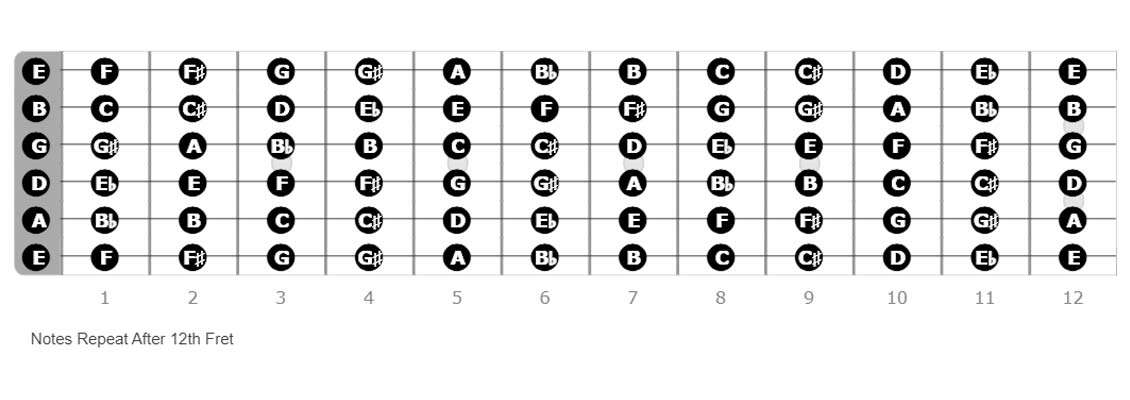Understanding the notes on the guitar fret board is a fundamental skill that can transform your playing and musical comprehension. Whether you’re a beginner or an experienced guitarist looking to deepen your knowledge, mastering the fretboard opens up a world of possibilities in composition, improvisation, and overall musicianship.
This guide will take you through the layout of notes across the entire neck, from the open strings to the highest frets. We’ll explore patterns, memorization techniques, and practical applications that will help you navigate the fretboard with confidence.
By the end, you’ll have a solid grasp of how notes are arranged on your guitar, enabling you to play more intuitively, craft better solos, and understand music theory in a tangible way. Let’s embark on this journey to unlock the full potential of your instrument.
Key Takeaways:

Beginning With The Open Strings
The foundation of understanding the guitar fretboard begins with the open strings. In standard tuning, the six strings of a guitar, from lowest (thickest) to highest (thinnest), are tuned to the following notes:
- Low E (6th string)
- A (5th string)
- D (4th string)
- G (3rd string)
- B (2nd string)
- High E (1st string)
These open string notes relate directly to the musical alphabet (A, B, C, D, E, F, G), which repeats cyclically. Notice that the guitar’s open strings don’t follow a straight alphabetical order, but instead create a unique interval pattern: perfect fourths between all adjacent strings except for the G and B strings, which have a major third interval.

Memorizing these open string notes is crucial, as they serve as reference points for all other notes on the fretboard. A common mnemonic device to remember this sequence is “Eddie Ate Dynamite, Good Bye Eddie.” With these open string notes as your anchor, you’re ready to explore the full range of notes across the entire fretboard.
Understanding the Fretboard Layout
How notes progress up the fretboard
As you move up the fretboard (towards the body of the guitar), each fret represents a half-step increase in pitch.
For example, on the low E string, the first fret is F, the second fret is F#/Gb, the third fret is G, and so on.
This consistent half-step progression applies to all strings, making the fretboard layout predictable and logical.
The chromatic scale on guitar

The chromatic scale includes all 12 notes in Western music and repeats across the entire fretboard.
Starting from any open string, you’ll find all 12 notes before the pattern repeats at the 12th fret. This means that the 12th fret of any string is the same note as the open string, just an octave higher.
Understanding the chromatic scale helps you navigate between notes and visualize the fretboard more clearly.
Octave patterns
Octaves are notes with the same letter name that are higher or lower in pitch. On the guitar, you can easily find octaves using a simple pattern: move up two strings and two frets (except when crossing from the G to B string, where it’s three frets).
For example, an A note on the 5th fret of the low E string has its octave on the 7th fret of the D string. Recognizing these octave patterns helps you locate notes quickly across the fretboard and understand the relationships between strings.
Fretboard Patterns & Landmarks
Understanding key patterns and landmarks on the guitar fretboard can significantly improve your navigation & playing skills. Let’s explore some essential concepts that will help you master the fretboard.
Octave Shapes

Octave shapes are consistent patterns that allow you to find the same note in different positions on the fretboard. The most common octave shape involves moving up two strings and two frets (except when crossing from the G to B string, where it’s three frets).
For example:
- An A on the 5th fret of the low E string has its octave on the 7th fret of the D string.
- A C on the 5th fret of the G string has its octave on the 8th fret of the B string.
Learning these shapes helps you quickly locate notes across the entire fretboard.
Unison Notes Across Strings

Unison notes are the same pitch played on different strings. Recognizing these can help you find alternative fingerings and create interesting harmonies. Common unison patterns include:
- Notes on the B string are the same as those four frets higher on the G string.
- Notes on the G string are the same as those five frets higher on the D string.
- This pattern of five frets continues for the lower strings.
Key Fretboard Markers

Most guitars have visual markers at specific frets, which serve as important reference points:
- 3rd fret: Often marked with a single dot, this fret is where you find G on the low E string.
- 5th fret: Another single dot, this is where you find A on the low E string and the note of the next open string for the top five strings.
- 7th fret: Usually marked with two dots, this fret is where you find B on the low E string.
- 12th fret: Typically marked with two dots or a special inlay, this fret represents an octave above the open string for all strings.
These markers help you quickly orient yourself on the fretboard and serve as reference points for finding other notes. Memorizing the notes at these key frets can greatly enhance your fretboard navigation skills.
Memorization Techniques
Mastering the guitar fretboard requires effective memorization techniques. Here are three powerful methods to help you internalize the notes and patterns across the neck, each with a practical example.
The CAGED System
The CAGED system uses five basic open chord shapes (C, A, G, E, and D) to visualize the fretboard.
Example: Let’s focus on the C shape. Play an open C chord, then move it up the neck to the 5th fret. Bar with your index finger and you’re now playing an F chord using the C shape.
This same principle applies to all CAGED shapes, allowing you to play any major chord across the fretboard.
Three-Note-Per-String Patterns
This technique involves playing scales using three notes on each string for consistent fingering patterns.
Example: For a G major scale, start on the 3rd fret of the low E string:
- Low E string: 3-5-7
- A string: 3-5-7
- D string: 3-5-7
- G string: 3-5-7
- B string: 3-5-6
- High E string: 3-5-7
Practice this pattern ascending and descending to build speed and familiarity.
Interval Relationships
Understanding intervals helps in quickly identifying notes and constructing chords and scales.
Example: The perfect fifth interval is crucial in power chords.
On the low E string, play the 5th fret (A). The perfect fifth of A is two strings up and two frets over, on the 7th fret of the D string (E). This same shape applies anywhere on the fretboard for the bottom four strings, making it easy to play power chords in any key.
By practicing these techniques regularly, you’ll develop a more intuitive understanding of the fretboard, enhancing your ability to compose, improvise, and play by ear.
Practical Applications
Understanding the fretboard isn’t just theoretical knowledge; it has numerous practical applications that can enhance your playing. Let’s explore how this knowledge translates into real-world guitar skills.
Finding Chord Tones
Knowing the fretboard allows you to quickly locate chord tones, which is crucial for creating riffs, solos, and chord voicings.
Example: Let’s take the C major chord (C, E, G). If you’re playing a solo over a C major progression:
- You can target the C note on the 8th fret of the high E string for emphasis.
- Jump to the E note on the 7th fret of the A string for a different flavor.
- End your phrase on the G note at the 3rd fret of the high E string for resolution.
This knowledge allows you to create more melodic and harmonically rich solos.
Building Scales Across the Fretboard
Understanding the fretboard layout helps you construct scales in any position, giving you more freedom in your playing.
Example: For a blues in A, you can play the A minor pentatonic scale in five positions:
- Open position (open A string to 3rd fret)
- 5th fret position
- 7th fret position
- 10th fret position
- 12th fret position
Knowing these positions allows you to move fluidly across the neck during a solo, rather than being stuck in one area.
Improvisation Using Fretboard Knowledge
Fretboard mastery opens up endless possibilities for improvisation, allowing you to express yourself more freely on the instrument.
Example: Imagine you’re jamming over a G-C-D progression:
- Over the G chord, you might emphasize the G notes (3rd fret on E string, open G string, 3rd fret on high E string).
- As it changes to C, you can smoothly shift to emphasize C notes (3rd fret on A string, 1st fret on B string).
- For the D chord, you can target D notes (5th fret on A string, open D string, 3rd fret on B string).
By knowing where these notes are across the fretboard, you can create fluid, musical solos that follow the chord changes seamlessly.
Applying your fretboard knowledge in these ways will not only improve your technical skills but also enhance your musicality and creativity. As you practice, you’ll find yourself becoming more intuitive with the instrument, able to express your musical ideas more effectively and spontaneously.
Conclusion
Mastering the notes on your guitar fretboard is like unlocking a whole new world of musical possibilities. It’s not just about memorizing where the notes are – it’s about understanding the patterns and logic behind the fretboard’s layout. As you dive deeper, you’ll see how everything connects, from the basic open strings to complex scale patterns.
Think of it as building blocks – each concept you learn builds on the last, giving you a complete picture of your guitar’s landscape. You’ve got different ways to approach this, like the CAGED system, three-note-per-string patterns, and understanding intervals. These different methods are great because they cater to different learning styles, so you’re bound to find one that clicks with you.
The best part? All this knowledge directly translates into your playing. You’ll find yourself navigating the fretboard with confidence, creating solos that really sing, and expressing your musical ideas more freely.
It’s a journey that keeps on giving, opening up new creative avenues and helping you grow as a musician. Trust me, the more you explore this, the more rewarding it becomes!
